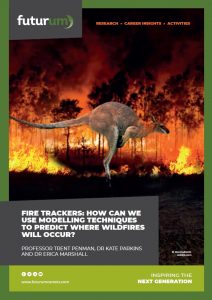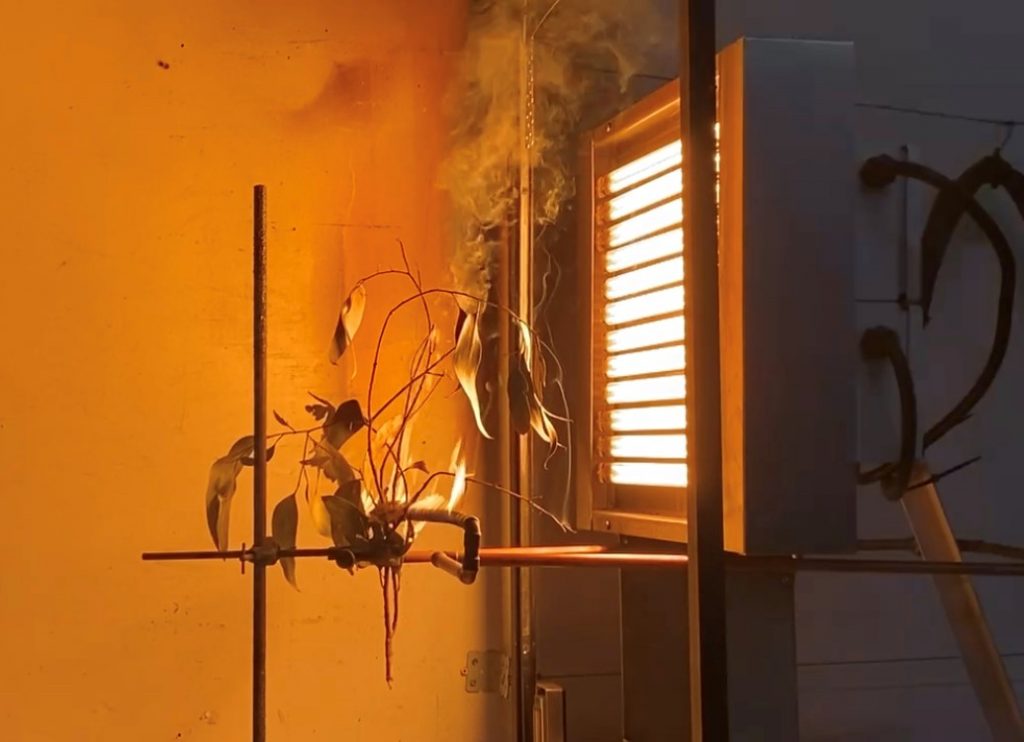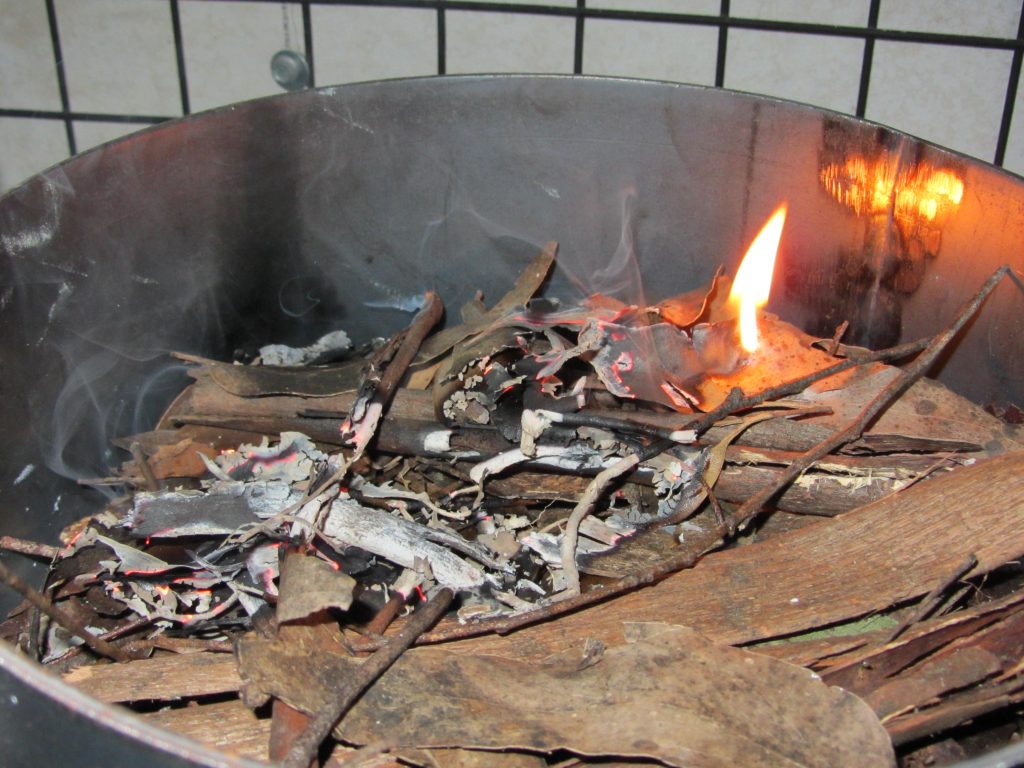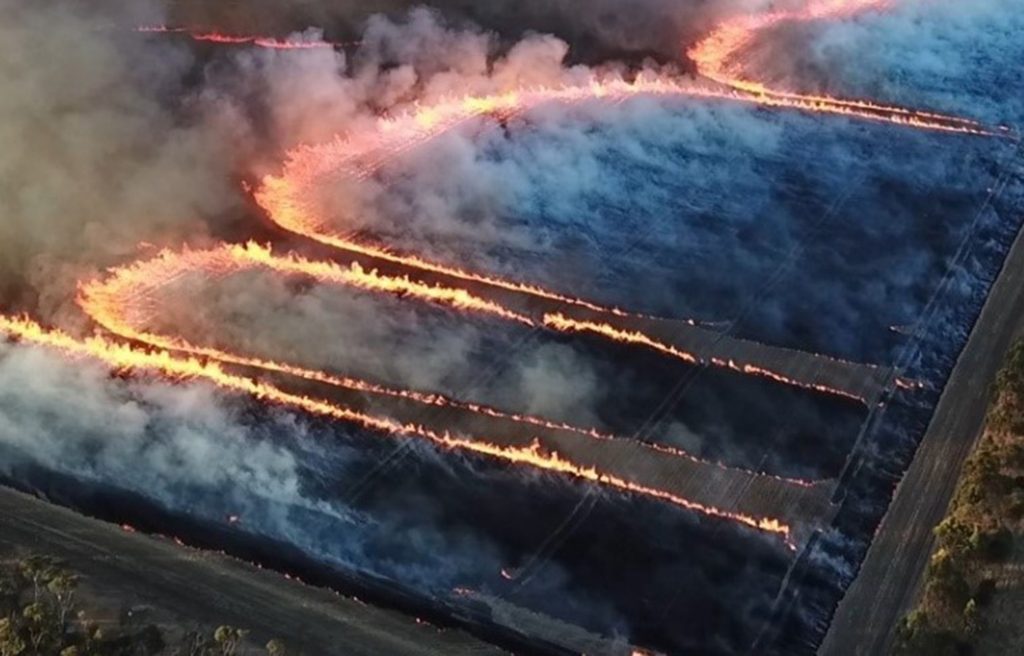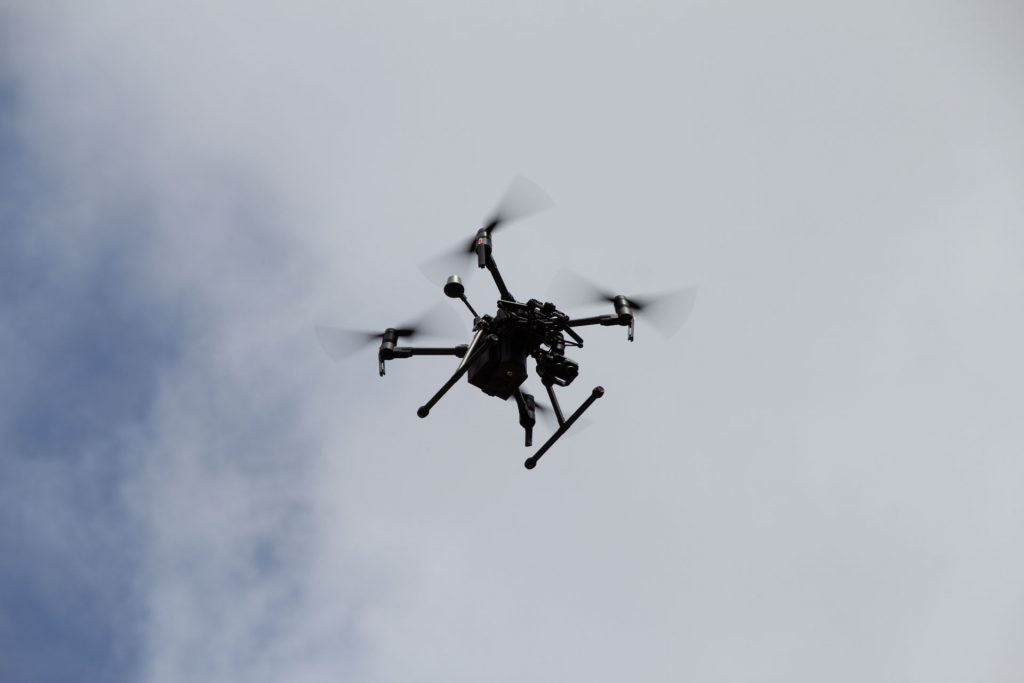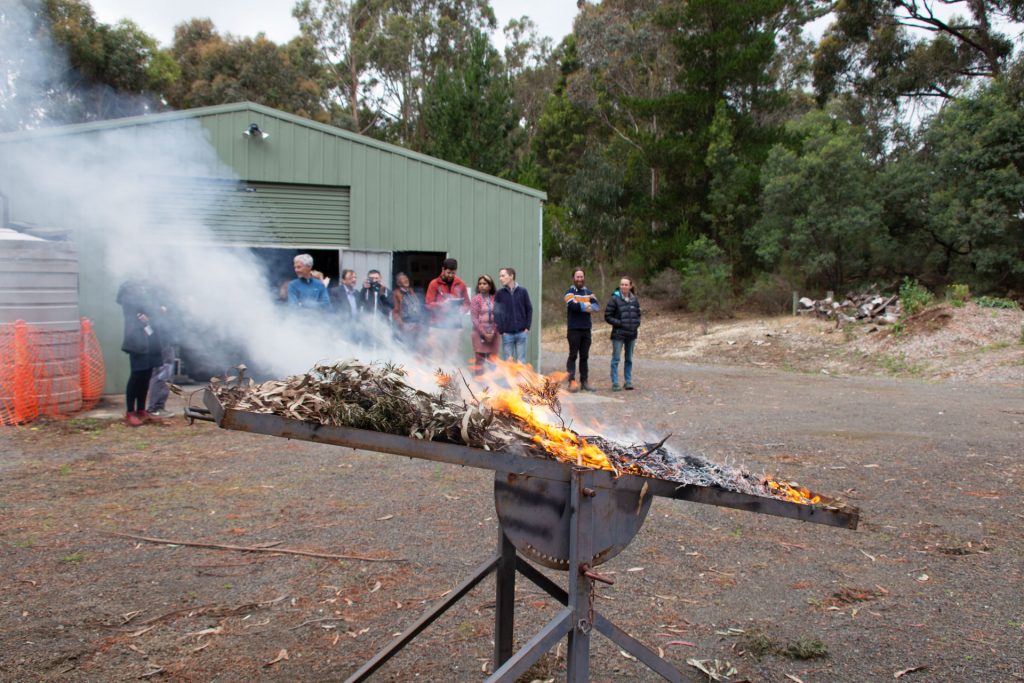Fire trackers: how can we use modelling techniques to predict where wildfires will occur?
Climate change is making many parts of the world hotter and drier. As a result, wildfires are becoming increasingly prevalent and pose a serious threat to human life, local communities and natural ecosystems. Researchers from the FLARE Wildfire Research Group at The University of Melbourne in Australia are developing models that can help predict where wildfires are most likely to occur and how fires behave under different weather conditions. Their research explores how fire management can be used to reduce the risk of damage to human values while maintaining or improving environmental values in the landscape.
TALK LIKE A BUSHFIRE RISK ANALYST
Bushfire or Wildfire — an unplanned fire that burns through large areas of scrub or forest
Variable heat flux — a measure of how quickly heat energy moves through or across a material
Prescribed burns — the controlled application of fire, also referred to as ‘controlled burns’, ‘hazard reduction burns’ or ‘planned burns’. This type of fire is deliberately applied to a pre-determined area at the time, intensity and rate of spread required to achieve the desired management objectives, and occurs under a strict set of environmental conditions
Fire suppression techniques — the various strategies for stopping a fire once it has started. These include: spraying a fire with large volumes of water or fire retardant (from the ground or through aerial attack); creating fuel breaks (areas cleared of vegetation by heavy machinery) to stop fire spread or provide safer places for fire fighters to work from; back-burning to reduce or remove fuel/vegetation in strategic areas (e.g. in areas where a fire is predicted to travel)
Fuel management — management aimed at reducing connectedness within and between different layers of fuel, by increasing the gap to the canopy to reduce the likelihood of fire reaching the upper layer of fuel, and removing bark to reduce spotting
During Australia’s “Black Summer” bushfire season of 2019-20, an area the size of the UK was impacted by bushfires. Tragically, more than 30 people lost their lives as a direct result of these fires, and over 3000 homes were destroyed. It is estimated that over a billion animals perished in these fires and that some species may even have been driven to extinction.
The total economic cost of the Black Summer fires has been calculated at around $80 billion, making them the most costly natural disaster in Australia’s history. Worryingly, extreme bushfire events of this scale are becoming more frequent, not just in Australia, but in many places around the world.
This increase in the frequency and severity of bushfires is being driven by, among other things, human-induced climate change. Since the industrial revolution, humans have emitted more than two trillion tonnes of carbon dioxide and other greenhouse gases into the atmosphere. These gases trap heat from the sun in the Earth’s atmosphere, which has led to the destabilisation of climate systems all around the globe. In many places, dry seasons are becoming longer and hotter, which can create perfect conditions for bushfires to start.
The risks associated with extreme bushfire events are being magnified as human populations continue to expand into forested areas. As human populations expand, we are seeing the associated expansion of the Wildland-Urban Interface (WUI). The WUI is defined as an area where people and houses are in close proximity to wildland vegetation. These areas are often characterised by very high fire risk due to the proximity of flammable vegetation and the difficulty of suppressing fires in these areas. As a result, understanding how bushfires behave and where they are likely to occur is more important than ever.
Professor Trent Penman, Dr Kate Parkins and Dr Erica Marshall are researchers from the FLARE Wildfire Research Group, based at The University of Melbourne. Through their research, Kate, Erica and Trent investigate bushfires in an attempt to better predict patterns of bushfire behaviour and occurrence. This will allow them to identify where future fire risks are highest, and help communities prepare for and manage the risks associated with bushfires.
What are the risks posed by bushfires?
“Bushfires can cause extensive impacts on the environment and people,” says Trent. “The most serious direct impacts include the immediate loss of life and property during extreme events.” Bushfires can also result in the widespread destruction of habitat and increase the risk to threatened plant and animal communities.
The impacts from extreme bushfire events can linger for a long time after the fires have been extinguished. This is particularly true for economic impacts, such as the loss of tourism, the destruction of farm crops and damage to local shops and businesses. Long-lasting economic impacts can put huge pressure on local communities. As families are displaced and community groups broken up, the mental health and well-being of people can come under serious strain.
The risks posed by bushfires may vary in different areas. Some communities may experience them more frequently and on larger scales than others, depending on their local climatic conditions and surrounding habitats. Gaining a deeper understanding of bushfires allows the team to more accurately assess the risks faced by different communities.
How does the team study bushfire behaviour?
The FLARE Wildfire Research Group has a purpose-built fire laboratory where it can investigate different aspects of fire behaviour. The fire lab is home to a variety of experimental equipment that allows researchers to conduct fire experiments in controlled, safe conditions. For example, the variable heat flux apparatus allows the team to study how different materials ignite and burn under different climatic conditions. The flame propagation apparatus allows the group to study how flames spread across different materials, and the IKA CA bomb calorimeter is used to determine how quickly heat is released from different substances. Fire experiments in the laboratory are just one part of how the team investigates fire behaviour. These lab-based studies are also scaled-up to a local or landscape scale through field experiments, where the team collects information about current fuel loads, as well as undertaking additional fire experiments in forested environments to capture real-time variability in weather and fuel moisture.
However, all of these devices pale in comparison to a new bit of kit that is currently under construction at the lab. A large-scale, 50 m wind tunnel will be used to generate large fires and investigate how they behave under extreme conditions, such as high wind speeds. The new wind tunnel, along with the other apparatus, will allow the team to collect all sorts of important data. These data can then be used to develop models which can help predict the occurrence, location and intensity of future bushfires.
Reference
https://doi.org/10.33424/FUTURUM353
How does the team study future bushfire risk?
The modelling programme that is most commonly used by the team is called FROST, which stands for Fire Regime Operations and Simulations Tool. This programme makes use of data that have been collected from lab experiments or field studies and combines them with fire behaviour simulations. This enables the team to determine how likely bushfires are to start in different places and under different climatic and weather conditions.
FROST can also incorporate data on biodiversity and the location of human settlements and structures. “For example, using data on the traits and ecological requirements of different plant species, we can examine how changing fire risk might affect different ecological communities,” explains Erica. Once the team has chosen a location that it wants to construct a model for, the researchers need to collect data. “These models we run use many, many data inputs,” says Erica. “These data capture the location of assets in the area, the distance to roads, vegetation type, soil moisture, rainfall, fire history and a myriad of climate information.” Collecting all these data can take a long time, and the team makes use of government databases, academic papers and its own field work and experiments to do so.
“It is essential that the information we collect and use in these models captures the unique ecological and environmental conditions of the region of interest,” says Kate. This helps the team make better predictions about how these areas might be affected by bushfires over longer time periods and under changing climatic conditions.
How does the team apply the models?
The models produced by FLARE are used to help solve a range of management problems. “Our work helps local and state agencies make decisions about wildfire risk management,” explains Kate. “Essentially, we help identify where current or future fire risk is the highest, and evaluate a series of different management strategies to determine which option, or combination of options, will provide the best risk reduction. This information provides a transparent and scientifically robust method for allocating limited fire management resources to ensure the biggest risk-reduction bang-for-buck.”
As our climate continues to change, more communities will be threatened by bushfires. Many of them may not have the knowledge or experience to deal with these extreme situations. As such, the team at FLARE is playing an important role in helping communities and industry be better prepared for changing climatic conditions and a future characterised by more frequent fires.

Professor Trent Penman | Dr Kate Parkins | Dr Erica Marshall
The University of Melbourne, Australia
Field of research: Fire risk analysis
Research: Investigating fire behaviour and impacts, and developing models that can help predict where wildfires are most likely to occur
Key Funders: e.g. Victorian Government Department of Environment, Land, Water and Planning; Greening Australia; Forest and Wood Products Australia; Energy Networks Australia
For more information on FLARE’s project partners, visit: www.flarewildfire.com/partners
ABOUT BUSHFIRE RISK ANALYSIS
Bushfires have been a part of the Australian environment for millions of years and have shaped the species and ecosystems we see today. Most systems require some fire to maintain diversity and function, and have evolved with natural fire regimes. However, these ecosystems can undergo significant changes in response to altered fire regimes caused by a changing climate.
As the effects of global climate change become more pronounced, bushfire management will become increasingly important. A better understanding of the economic, social and environmental consequences of major bushfires is important for reducing impacts to businesses, communities, individuals and ecosystems. Extreme bushfire events will increase in severity, intensity and duration. They will become a problem in more places around the world, increasing the demand for bushfire researchers and risk analysts.
How can the next generation of bushfire researchers be successful?
“Wildfire research is increasingly becoming an interdisciplinary field,” says Kate. “It involves not just fire behaviour but also animal ecology, human ethics, social science, engineering, politics, environmental law, health science and mathematics.” The future of wildfires globally poses a serious and complex challenge, and to manage the risks that come with a future characterised by more frequent and extreme fires, we need to integrate knowledge and learnings from many different disciplines. Having a range of skills is extremely beneficial as there will be opportunities for science communicators, media experts, policy makers and land managers, as well as researchers.
The next generation should make use of opportunities to incorporate both new and old knowledge into its work. “Fire managers and researchers are increasingly looking towards Indigenous knowledge on burning practices for insights into how we can better manage the landscape,” says Trent. Many Indigenous communities have lived in close harmony with nature for centuries, if not millennia. As a result, they have an intimate understanding of their native lands and how best to manage them.
What range of expertise is there in FLARE?
FLARE Wildfire Research Group is one of Australia’s largest fire research groups. “In our group, we have an incredibly broad range of skills and backgrounds including landscape and animal ecology, combustion engineering, forest science, mathematical modelling, and some data analysis and computer programming thrown in for good measure,” explains Erica.
Every researcher at FLARE has followed a unique path to their current work. This diversity of research experience enables them to investigate and answer some of the complex questions that face fire management agencies all over the world. “Having this fantastic diversity of backgrounds and skill sets allows us to do innovative, unique and rigorous research on a range of wildfire related subjects,” says Trent.
What is a typical day like for FLARE researcher?
Most of the day-to-day activities focus on conducting research, either through experiments, field-work or simulation modelling. The team also spends a lot of time writing up research papers, communicating with industry partners and carrying out statistical modelling.
Erica explains, “On an average day, we might be writing new code for our models, analysing field and experimental data, or engaging with collaborators about common research projects.” Documenting the group’s work in the form of reports, peer-reviewed publications and presentations is also vital. “This process is critical for getting our research into the scientific community and advancing the collective knowledge on wildfire risk,” says Kate.
What is rewarding about being a bushfire researcher?
The work of bushfire researchers can have significant impacts on how land managers understand and manage fire. “Knowing that the work we do is respected and applied by local and state governments, as well as our private industry partners, is very rewarding,” says Trent. “Every improvement to our understanding of bushfire risks can improve our management of those risks and potentially prevent impacts on the environment and our communities.”
Pathway from school to bushfire risk analysis
• At school and post-16, take maths alongside other science subjects like biology and chemistry.
• Learn about the practical skills that you might need for field data collection. “For me, this is the best part,” says Kate. “I love getting out in the field and collecting information on species, ecosystems or processes. You get to see some incredible places that not many people get to explore. It’s amazing.”
• As well as collecting data, you need to know what to do with them. A good knowledge of statistics and coding is vital for analysing data. “We use statistics on a weekly, if not daily, basis,” says Erica. “A lot of the data analysis we do also involves coding, which helps to speed up our ability to answer complex questions and allows us to do incredibly complicated modelling over very broad time scales.”
• Written and verbal communication is also key for sharing research findings. Studying English, drama or other art subjects can help with developing these skills. “Science should be shared widely with different and diverse audiences,” says Kate. “The ability to communicate complicated science in a simple and engaging manner is really important. While they may seem very removed from the scientific world, the skills you will learn in these subjects will be very helpful if you choose a career in science.”
• Studying a wide range of topics will make you a more well-rounded scientist. “I have a degree in acting and TV production, a master’s in environmental science and a PhD in fire ecology,” says Kate. “The skills I have gained in these vastly different fields has been more beneficial than I could have ever predicted.”
Explore careers in bushfire risk analysis
• Volunteer with local environmental groups. Being curious and learning about the issues in your local area can give you an insight into the kinds of issues that people face in other parts of the world as well.
• Volunteer with the fire service in your town. Many of these organisations actively encourage young people to get involved. If you live in an area where fires are common, this is a great way to learn more about them. If bushfires are not common in your area, you will still learn a lot about how fire works and how people fight it. As well as learning a lot about fire behaviour and risks, you will also help people in your local area and become an active part of your community.
• Take opportunities to get out into nature and take note of the thing around you. “The more you know about the world around you, the better you can work to protect it,” says Kate.
• You can learn more about FLARE and its research projects on its website.
• The Leverhulme Centre for Wildfires, Ecology and Society website is a great resource to learn
more about bushfires and how they affect ecosystems and communities. Its website has sections for new research being published, the latest news in wildfire research and jobs. It also hosts events and talks where you can learn more about the field of bushfire research.
• Get in touch with your local university or college to see if it has a department that studies bushfire management and offers any volunteering or research opportunities. Gaining experience of working as a researcher of any kind can provide you with valuable experience and help you explore your career options.
Meet Kate
What were your interests when you were growing up?
As a kid, I always had my pockets full of something. I couldn’t help myself – I was constantly picking things up to take home and investigate later. I collected rocks, plants, sand, sticks and shells… I was always rescuing injured birds, insects, lizards and worms. I just really loved being out in nature.
I had a strong environmental focus from an early age. When I was about 12, I joined a local ‘Stream Watch’ club that assessed water quality and surveyed the local aquatic wildlife once a month. This taught me a lot about how to run scientific experiments, and I was hooked. However, I also really loved acting and singing, so I was often torn between science and the arts. The best part of my current role is that I can combine my love of science with my love of communicating to explain science in fun and exciting ways.
Who inspired you to become a scientist?
David Attenborough’s documentaries were mind-blowing to me as a kid. I would watch these films and make a ‘bucket list’ of species I wanted to see and places I wanted to go one day. I was also extremely lucky to have family friends who were working zoologists, so I spent many holidays with them wading through lakes, chasing frogs or spotlighting (a way of observing nocturnal animals in the dark). I knew from an early age that I wanted a job that felt meaningful, and that allowed me to be out in nature.
What attributes have made you successful as a scientist?
I think one of the key things that makes me a successful scientist is that I have a deep curiosity about the world around me and a drive to do research that will have direct and tangible impacts. I like tricky and complicated questions, and I am motivated to find the answers. Another important aspect that makes a good scientist is the ability to work as part of a team. Being a good listener, having excellent attention to detail, good communication skills, kindness, empathy and motivation! All of these are important aspects.
What are your proudest career achievements, so far?
The day I found out that I had been awarded a scholarship to do my PhD was one of my proudest moments. Hard work and perseverance really do pay off. My parents always said to me, “you really can do anything if you just put your mind to it” and they were right. This is something I try to remember as I go through my career. I did a small research project through my master’s, studying our largest owl species here in Australia (the powerful owl, Ninox strenua). Through this study, I started to have a lot of questions about how a series of prescribed burns might affect the population of owls I was researching, and I knew that I needed to pursue a career in research. So, getting accepted and then completing a PhD in fire ecology at Australia’s top university was certainly one of my proudest moments.
What are your ambitions for the future?
I am very passionate about diversity and inclusion in science, and fostering the next generation of scientists. I hope to continue to mentor and encourage new students in this field. I aim to continue the work I am doing in fire risk and fire ecology research, in the hope that my research can help reduce the impact of future wildfires. I’ve never really had a big picture career goal; I have simply said yes to opportunities, worked hard, been kind and curious, and followed whatever path has presented itself to me. I plan to continue doing this for as long as I can!
Kate’s top tips
1. You really can do anything you put your mind to!
2. Don’t be afraid to ask questions.
3. Don’t shy away from hard work.
4. Pay attention to the world around you, and be as focused as you can in statistics classes! (I learnt this the hard way!)
5. Take every opportunity and try lots of different things until you find your niche.
Meet Erica
What were your interests when you were growing up?
Growing up in New Zealand, I loved nature. I was very lucky to live near a beach, and I was always exploring rock pools or fishing with my family. When I was young, I wanted to become a marine biologist, but I also had a vivid imagination. Any time I got in the water, I was scared that sharks were surrounding me, waiting to attack. Unfortunately, this put me off marine biology fairly quickly! I was also really interested in ancient cultures, so I channelled that imagination into exploring ancient Greece and Egypt. This led to an interest in archaeology and anthropology. I actually ended up doing biological anthropology as a major when I went to university, alongside my biology degree.
Who or what inspired you to become a scientist?
I was always really interested in science, but I certainly did not think I was good at science in school. I had one science teacher in early high school who just knew how to make science accessible. She saw that I had the potential to do well if I applied myself, and she pushed me to do so. One day, I was sitting in the library working and she rushed over with a big grin and my latest test score. All she said was, “I told you so”. Her excitement was infectious, and I was super proud of myself. She was passionate about science, but more importantly she was passionate about learning. She really inspired and mentored me to find a way of learning that worked for me, and that love of learning really helped me discover my passion for science.
What attributes have made you successful as a scientist?
I think some of the best attributes to have as a scientist are curiosity, collaboration and communication. No one knows everything, and you never need to know everything because, ideally, you are just one part of the solution. The rest of the solution might come from your research group, your collaborators, or the scientific community in general. Working well in a team is a key part of science and a skill that can be improved every day and as you gain more experience as a scientist. I am still learning new things.
What are your proudest career achievements, so far?
Since finishing my PhD, the work I have done in FLARE on wildfire research has been taken on board by several groups, including government agencies. Knowing that my research is being applied through government policies and procedures to improve risk management is probably one of my proudest achievements. It is really rewarding to know that the science you are doing makes a difference, even if that difference feels small.
What are your ambitions for the future?
I love research and the problem-solving aspect of my current research in particular. I hope that one day I can find a permanent research position where I can lead my own research. As a woman in STEM, I also think I have been really lucky in my life and career to have so many strong, inspiring female leaders to take example from. I hope I can pay it forward to future generations of researchers as a mentor or supervisor. I would like to see more amazing, unique and diverse people bringing their ideas into science.
Erica’s top tips
1. Keep an open mind.
2. Keep going, even when it feels like you’ve failed. Everyone makes mistakes, and it’s important to learn from them.
3. Maintain a balance between work and the other things that give life meaning.
Write it in the comments box below and Trent, Kate or Erica will get back to you. (Remember, researchers are very busy people, so you may have to wait a few days.)

